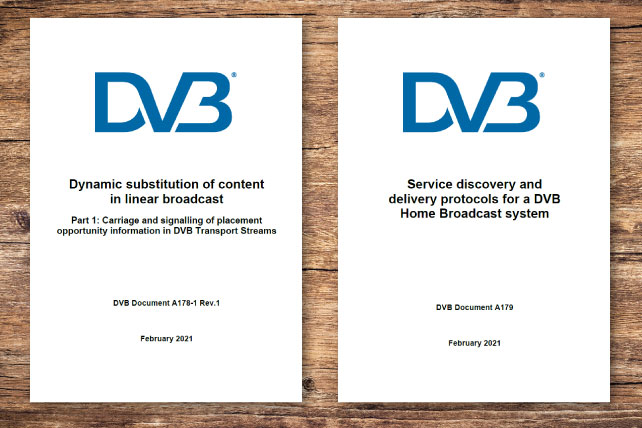
Steering Board approves DVB-TA watermarking and DVB Home Broadcast spec
Last week’s meeting of the DVB Steering Board approved the publication of two BlueBooks, one an updated specification and the other a new specification. The DVB Targeted Advertising specification has been updated (BlueBook A178-1r1) to include watermarking as an alternative way to signal where content can be inserted in a broadcast. DVB Home Broadcast (BlueBook A179) is a solution to enable in-home redistribution of broadcast TV services to IP devices.
The Steering Board also approved the creation of a task force to examine what activity, if any, DVB might undertake to support the implementation of the EU AVMS Directive with respect to DVB systems. The Audiovisual Media Services Directive governs EU-wide coordination of national legislation on all audiovisual media, both traditional television broadcasts and on-demand services. DVB Members with an interest in this matter are encouraged to join the group.
An update to the DVB Workplan was also approved, setting out current CM and TM work items and their anticipated completion dates.
Enabling DVB-TA via legacy receivers
The two-part DVB Targeted Advertising specification was published by ETSI last December, paving the way for broadcasters to tap into new revenue streams by offering more impactful advertising campaigns and personalized content on linear broadcast networks. A key new option has been added to the first part of the specification, where watermarking can now be used for signalling.
The goal of adding signalling on media essence – or SoME – is to enable DVB Targeted Advertising for connected TV sets displaying a linear broadcast service received by a legacy (non-connected) set-top box. Because the signalling of the content insertion opportunity resides in the media essence and persists through transcoding and multiplexing, it can be embedded by the broadcaster and delivered to the receiver without any need for specialized handling at the network or platform operator. It can pass through network/platform operator systems seamlessly.
DVB BlueBook A178-1r1 sees the addition of Chapter 8 covering the technical aspects of using SoME, as well as a pair of annexes providing information related to specific target platforms and guidance on mitigating user experience issues that can arise when watermark-based signalling is employed.
The creation of Verification & Validation (V&V) materials to aid implementation is under way. When this V&V process has been completed, the update will be sent to ETSI for formal standardization as a revision of TS 103 752-1.
DVB Home Broadcast
The DVB-HB specification is designed to enable client devices likes smartphones, tablets or HDMI dongles to access and consume broadcast content that has been re-transmitted over IP by a server located in the same local network. It can thus convert any IP-enabled device into a TV receiver, allowing it to receive services at broadcast quality.
Applications could also extend beyond the home into hospitality environments, hotels, Wi-Fi hotspots, etc. The solution is backwards-compatible with existing SAT>IP servers and clients and is designed to also be compatible with emerging DVB-I clients.
The development of V&V materials is ongoing and the specification will be sent to ETSI for standardization upon completion of the V&V package.
Find all DVB standards and BlueBooks in our Specification Library.
